Numerical Simulation of Acoustic Resonance Enhancement for Mean Flow Wind Energy Harvester as Well as Suppression for Pipeline
Abstract
1. Introduction
- For wind-energy harvesting, acoustic resonance can output standing waves in the closed side branch without moving parts, providing continuous pressure fluctuation for wind harvesting equipment [1,2,3,4] or temperature difference for thermo-acoustic engines [5,6], the acoustic resonance, in this case, needs to be strengthened to improve utilization efficiency [7].
- Closed side branches exist widely in industry, such as natural gas transmission pipelines [8,9], safety valves of the steam pipeline in nuclear power plant [10,11,12,13,14,15], a vertical-lift system of fighters [16,17,18]. Acoustic resonance in these cases can induce severe vibration and noise, cause fatigue damage to the pipeline, threaten the safe operation of the pipeline, and even cause safety accidents, which need to be avoided or suppressed. Therefore, it is of practical significance to enhance or suppress acoustic resonance.
2. Mathematical Methods
2.1. Geometry Model
2.2. Grid Partition
2.3. Boundary Conditions
2.4. CFD Turbulence Model and Solver
2.5. Grid Analysis and Validation
3. Influences of Pipe Cross-Section Shape
3.1. Onset and Offset of Acoustic Resonance
3.2. Vorticity Around the Branch Mouth
3.3. Influence of Intersection Line on Vortex Oscillation of z-Velocity
4. Effects of Branch Angle
4.1. Beats Phenomena
4.2. Acoustic Resonance Characteristics
4.3. Vortex Modes and Pressure Contours
5. Conclusions
- The Strouhal number range from onset to offset of acoustic resonance were consistent in the circular branch and the equivalent diameter square branch, which indicated that the results studied in these two shapes pipe were universal for predicting the occurrence of acoustic resonance. The vortex modes in the branch mouths were similar, which indicated the similarity of the mechanisms in these two shapes;
- The intersection line of the circular pipe intensified the z-direction oscillation of the sound vortex at the branch mouth, which led to energy dissipation and reduced the pressure fluctuation amplitude of the acoustic resonance caused by the sound source excitation. Therefore, compared with the circular branch, acoustic resonance in the equivalent square branch provided higher pressure pulsation and was more efficient in wind energy harvesting. The design of a square wind energy harvester was better than that of a circular one;
- At a certain flow rate, acoustic resonance show unstable beats phenomena. These phenomena were independent of the shape of the pipe and were related to whether the flow velocity in the main pipe was close to the frequency conversion point;
- The branch angle α had a significant effect on the acoustic resonance. It was found that changing the branch angle could increase or suppress the acoustic resonance, which could improve the utilization efficiency of the acoustic resonance and provide a new method for suppressing the acoustic resonance. As α = 60°, the acoustic resonance maintains the first-order frequency in a wide range of flow velocity, which could be more efficient in wind energy harvesting. As α = 120°, the acoustic resonance was suppressed in a wide range of velocity, which could be more efficient and economical to suppress the acoustic resonance in the gas transmission pipeline system;
- In the present simulation, all cases were initialized from the inlet with the corresponding mass-flow rate. Taking the quasi-steady acoustic resonance state of one flow velocity as the initial state of another flow velocity was expected to reduce the cost of the solution. However, the impact of this operation should be further studied. In addition, the effect of changing the branch angle shows great potential application value. Therefore, it is worthy of further study to verify this effect by experimental method.
Author Contributions
Funding
Institutional Review Board Statement
Informed Consent Statement
Data Availability Statement
Conflicts of Interest
References
- Sun, D.; Xu, Y.; Chen, H.; Shen, Q.; Zhang, X.; Qiu, L. Acoustic characteristics of a mean flow acoustic engine capable ofwind energy harvesting: Effect of resonator tube length. Energy 2013, 55, 361–368. [Google Scholar] [CrossRef]
- Sun, D.; Xu, Y.; Chen, H.; Wu, K.; Liu, K.; Yu, Y. A mean flow acoustic engine capable of wind energy harvesting. Energy Conver. Manag. 2012, 63, 101–105. [Google Scholar] [CrossRef]
- Yu, Y.S.W.; Sun, D.; Zhang, J.; Xu, Y.; Qi, Y. Study on a Pi-type mean flow acoustic engine capable of wind energy harvesting using a CFD model. Appl. Energy 2017, 189, 602–612. [Google Scholar] [CrossRef]
- Yu, Y.; Sun, D.; Wu, K.; XU, Y.; Chen, H.; Zhang, X.; Qiu, L. CFD study on mean flow engine for wind power exploitation. Energy Convers. Manag. 2011, 52, 2355–2359. [Google Scholar] [CrossRef]
- Slaton, W.V.; Zeegers, J.C.H. Acoustic power measurements of a damped aeroacoustically driven resonator. J. Acoust. Soc. Am. 2005, 118, 83–91. [Google Scholar] [CrossRef] [PubMed]
- Slaton, W.V.; Zeegers, J.C.H. An aeroacoustically driven thermoacoustic heat pump. J. Acoust. Soc. Am. 2005, 117, 3628. [Google Scholar] [CrossRef] [PubMed]
- Luo, E. Experimental Study on Thermoacoustic Refrigerators Driven by a Travelling-Wave Thermoacoustic Engine. In AIP Conference Proceedings; AIP Publishing: New York, NY, USA, 2003. [Google Scholar]
- Tonon, D.; Hirschberg, A.; Golliard, J.; Ziada, S. Aeroacoustics of pipe systems with closed branches. Noise Notes 2011, 10. [Google Scholar] [CrossRef]
- Kriesels, P.C.; Peters, M.C.A.M.; Hirschberg, A. High amplitude vortex-induced pulsations in a gas transport system. J. Sound Vibrat. 1995, 184, 343–368. [Google Scholar] [CrossRef]
- DeBoo, G.; Gesior, R.; Ramsden, K.; Strub, B. Identification of quad cities main steam line acoustic sources and vibration reduction. In American Society of Mechanical Engineers, Pressure Vessels and Piping Division (Publication) PVP; American Society of Mechanical Engineers: New York, NY, USA, 2008; Volume 4, pp. 485–491. [Google Scholar]
- Baldwin, R.M.; Simmons, H.R. Flow-induced vibration in safety relief valves. J. Press. Vessel Technol. 2009, 120, 267–272. [Google Scholar] [CrossRef]
- Okuyama, K.; Tamura, A.; Takahashi, S.; Ohtsuka, M.; Tsubaki, M. Flow-induced acoustic resonance at the mouth of one or two side branches. Nuclear Eng. Des. 2012, 249, 154–158. [Google Scholar] [CrossRef]
- Xiao, Y.; Gu, H.; Gao, X.; Zhang, H.; Zhao, W. Flow visualization study of flow-induced acoustic resonance in closed side branches. Ann. Nuclear Energy 2018, 149, 107783. [Google Scholar] [CrossRef]
- Xiao, Y.; Zhao, W.; Gu, H.; Gao, X. Effects of branch length and chamfer on flow-induced acoustic resonance in closed side branches. Ann. Nuclear Energy 2018, 121, 186–193. [Google Scholar] [CrossRef]
- Tamura, A.; Okuyama, K.; Takahashi, S.; Ohtsuka, M. Development of numerical analysis method of flow-acoustic resonance in stub pipes of safety relief valves. J. Nuclear Sci. Technol. 2012, 49, 793–803. [Google Scholar] [CrossRef]
- Bravo, R.; Ziada, S.; Dokainish, M. Aeroacoustic Response of an Annular Duct with Coaxial Closed Side Branches. In Collection of Technical Papers, Proceedings of the 11th AIAA/CEAS Aeroacoustics Conference, Monterrey, CA, USA, 23–25 May 2005; ARC: Reston, VA, USA, 2005. [Google Scholar]
- Arthurs, D.; Ziada, S.; Bravo, R. Flow induced acoustic resonances of an annular duct with co-axial side branches. In American Society of Mechanical Engineers, Pressure Vessels and Piping Division (Publication) PVP; American Society of Mechanical Engineers: New York, NY, USA, 2006. [Google Scholar]
- Arthurs, D.; Ziada, S. Flow-excited acoustic resonances of coaxial side-branches in an annular duct. J. Fluids Struct. 2009, 25, 42–59. [Google Scholar] [CrossRef]
- Ziada, S. Flow-excited acoustic resonance in industry. J. Press. Vessel Technol. Trans. ASME 2010, 132, 015001. [Google Scholar] [CrossRef]
- Ziada, S.; Lafon, P. Flow-excited acoustic resonance excitation mechanism, design guidelines, and counter measures. Appl. Mech. Rev. 2014, 66, 010802. [Google Scholar] [CrossRef]
- Dequand, S.; Hulshoff, S.J.; Hirschberg, A. Self-sustained oscillations in a closed side branch system. J. Sound Vibrat. 2003, 265, 359–386. [Google Scholar] [CrossRef]
- Li, Y.; Someya, S.; Okamoto, K.; Inagaki, T.; Nishi, Y. Study on flow-induced acoustic resonance in symmetrically located side-branches using dynamic PIV technique. J. Fluid Sci. Technol. 2014, 9. [Google Scholar] [CrossRef]
- Li, Y.; Someya, S.; Okamoto, K.; Inagaki, T.; Nishi, Y. Visualization study of flow-excited acoustic resonance in closed tandem side branches using high time-resolved particle image velocimetry. J. Mech. Sci. Technol. 2015, 29, 989–999. [Google Scholar] [CrossRef]
- Salt, E.; Mohamed, S.; Arthurs, D.; Ziada, S. Aeroacoustic sources generated by flow-sound interaction in a T-junction. J. Fluids Struct. 2014, 51, 116–131. [Google Scholar] [CrossRef]
- Salt, E.; Mohamed, S.; Arthurs, D.; Ziada, S. Identification of aeroacoustic sources in a T-junction. In American Society of Mechanical Engineers, Pressure Vessels and Piping Division (Publication) PVP; American Society of Mechanical Engineers: New York, NY, USA, 2014. [Google Scholar]
- Ziada, S. A flow visualization study of flow- acoustic coupling at the mouth of a resonant side-branch. J. Fluids Struct. 1994, 8, 391–416. [Google Scholar] [CrossRef]
- Ziada, S.; Shine, S. Strouhal numbers of flow-excited acoustic resonance of closed side branches. J. Fluids Struct. 1999, 13, 127–142. [Google Scholar] [CrossRef]
- Bruggeman, J.C.; Hirschberg, A.; van Dongen, M.E.H.; Wijnands, A.P.J.; Gorter, J. Self-sustained aero-acoustic pulsations in gas transport systems: Experimental study of the influence of closed side branches. J. Sound Vib. 1991, 150, 371–393. [Google Scholar] [CrossRef]
- Jiang, L.; Zhang, H.; Duan, Q.; Zhang, Y. Numerical study on acoustic resonance excitation in closed side branch pipeline conveying natural gas. Shock Vibrat. 2020, 2019, 8857838. [Google Scholar] [CrossRef]
- Jungbauer, D.E.; Eckhardt, L.L. Flow-induced noise and vibration in turbocompressors and piping systems. Hydrocarb. Process. 2000, 79, 7. [Google Scholar]
- Yu, Y.; Sun, D.M.; Ma, J.F.; Xu, Y.Q.; Chen, H.; Wu, K.; Ao, W.; Yan, W.; Qiu, L. Experimental study on acoustic characteristics of mean flow acoustic engine. J. Eng. Thermophys. 2012, 33, 23–26. [Google Scholar]
- Morita, R.; Takahashi, S.; Okuyama, K.; Inada, F.; Ogawa, Y.; Yoshikawa, K. Evaluation of acoustic- and flow-induced vibration of the BWR main steam lines and dryer. J. Nuclear Sci. Technol. 2011, 48, 759–776. [Google Scholar] [CrossRef]
- Radavich, P.M.; Selamet, A.; Novak, J.M. A computational approach for flow–acoustic coupling in closed side branches. J. Acoust. Soc. Am. 2001, 116, 105–112. [Google Scholar] [CrossRef]
- Spalart, P.R.; Deck, S.; Shur, M.L.; Squires, K.D.; Strelets, M.K.; Travin, A. A new version of detached-eddy simulation, resistant to ambiguous grid densities. Theor. Comput. Fluid Dyn. 2006, 20, 181–195. [Google Scholar] [CrossRef]
- Tan, X.M.; Xie, P.P.; Yang, Z.G.; Gao, J.Y. Adaptability of turbulence models for pantograph aerodynamic noise simulation. Shock Vibrat. 2019, 2019, 6405809. [Google Scholar] [CrossRef]
- Zhang, Y.; Zhang, J.; Li, T.; Zhang, L.; Zhang, W. Research on aerodynamic noise reduction for high-speed trains. Shock Vibrat. 2016, 2016. [Google Scholar] [CrossRef]
- Jeong, S.M.; Choi, J.Y. Combined diagnostic analysis of dynamic combustion characteristics in a scramjet engine. Energies 2020, 13, 29. [Google Scholar] [CrossRef]
- Sedano, C.A.; Berger, F.; Rahimi, H.; Lopez Mejia, O.D.; Kühn, M.; Stoevesandt, B. CFD validation of a model wind turbine by means of improved and delayed detached eddy simulation in openFoam. Energies 2019, 12, 1306. [Google Scholar] [CrossRef]
- Li, J.; Hu, J.; Zhang, C. Investigation of vortical structures and turbulence characteristics in corner separation in an axial compressor stator using DDES. Energies 2020, 13, 2123. [Google Scholar] [CrossRef]
- ANSYS. ANSYS Fluent User’s Guide; ANSYS Inc.: Canonsburg, PA, USA, 2019. [Google Scholar]
- Yuan, Q.; Yu, B.; Li, J.; Han, D.; Zhang, W. Study on the restart algorithm for a buried hot oil pipeline based on wavelet collocation method. Int. J. Heat Mass Transf. 2018. [Google Scholar] [CrossRef]
- Zhang, K.; Li, J.; Yu, B.; Han, D.; Chen, Y. Fast prediction of the replacement process of oil vapor in horizontal tank and its improved safety evaluation method. Process Saf. Environ. Protect. 2019, 122, 298–306. [Google Scholar] [CrossRef]
- Shao, Z.; Zhou, T.; Zhu, H.; Zang, Z.; Zhao, W. Amplitude enhancement of flow-induced vibration for energy harnessing. E3S Web Conf. 2020, 160. [Google Scholar] [CrossRef]
- Zhu, H.; Zhao, Y.; Zhou, T. CFD analysis of energy harvesting from flow induced vibration of a circular cylinder with an attached free-to-rotate pentagram impeller. Appl. Energy 2018, 212, 304–321. [Google Scholar] [CrossRef]
- Zhu, H.; Zhao, Y.; Hu, J. Performance of a novel energy harvester for energy self-sufficiency as well as a vortex-induced vibration suppressor. J. Fluids Struct. 2019, 91, 102736. [Google Scholar] [CrossRef]
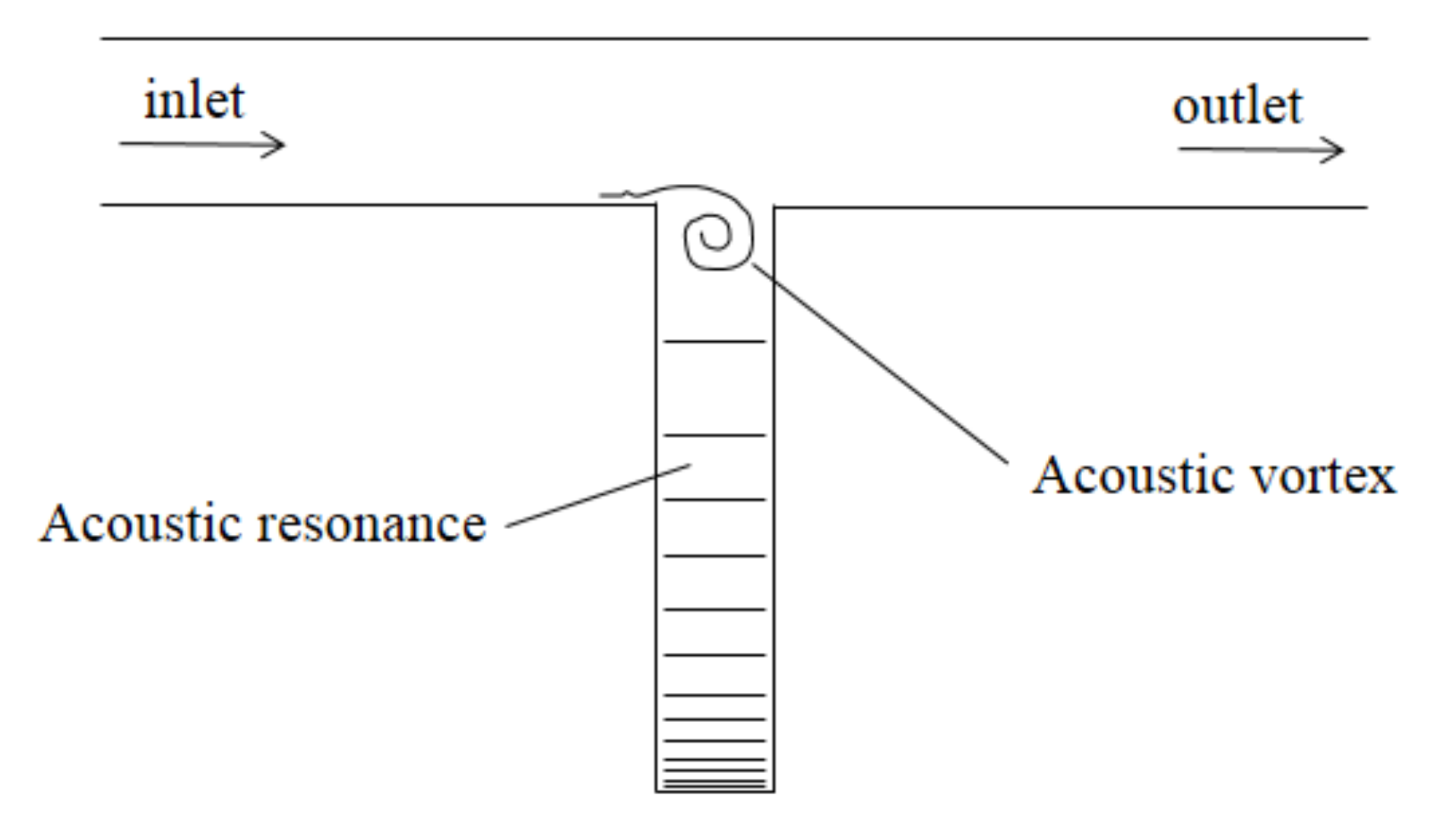
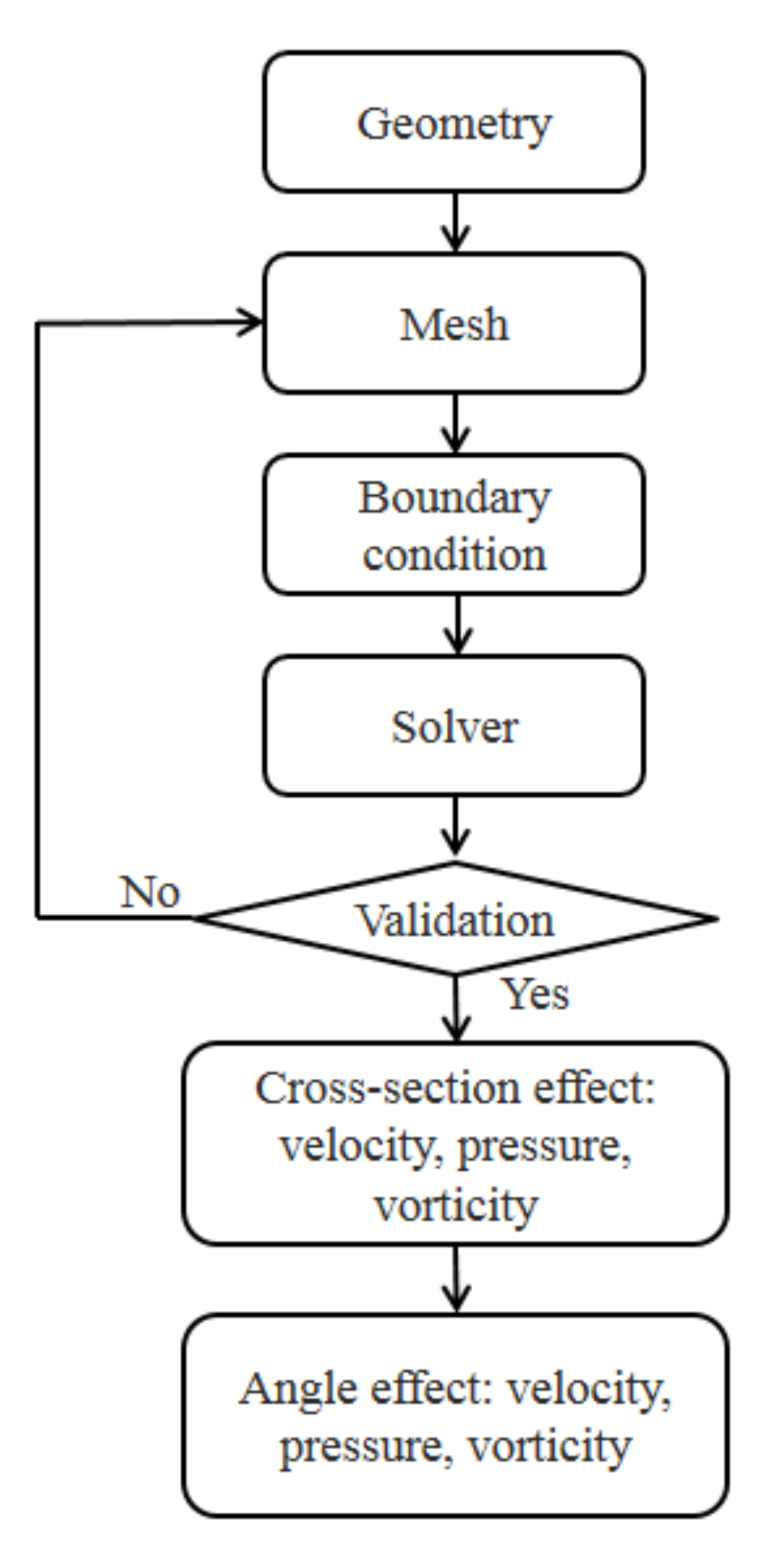
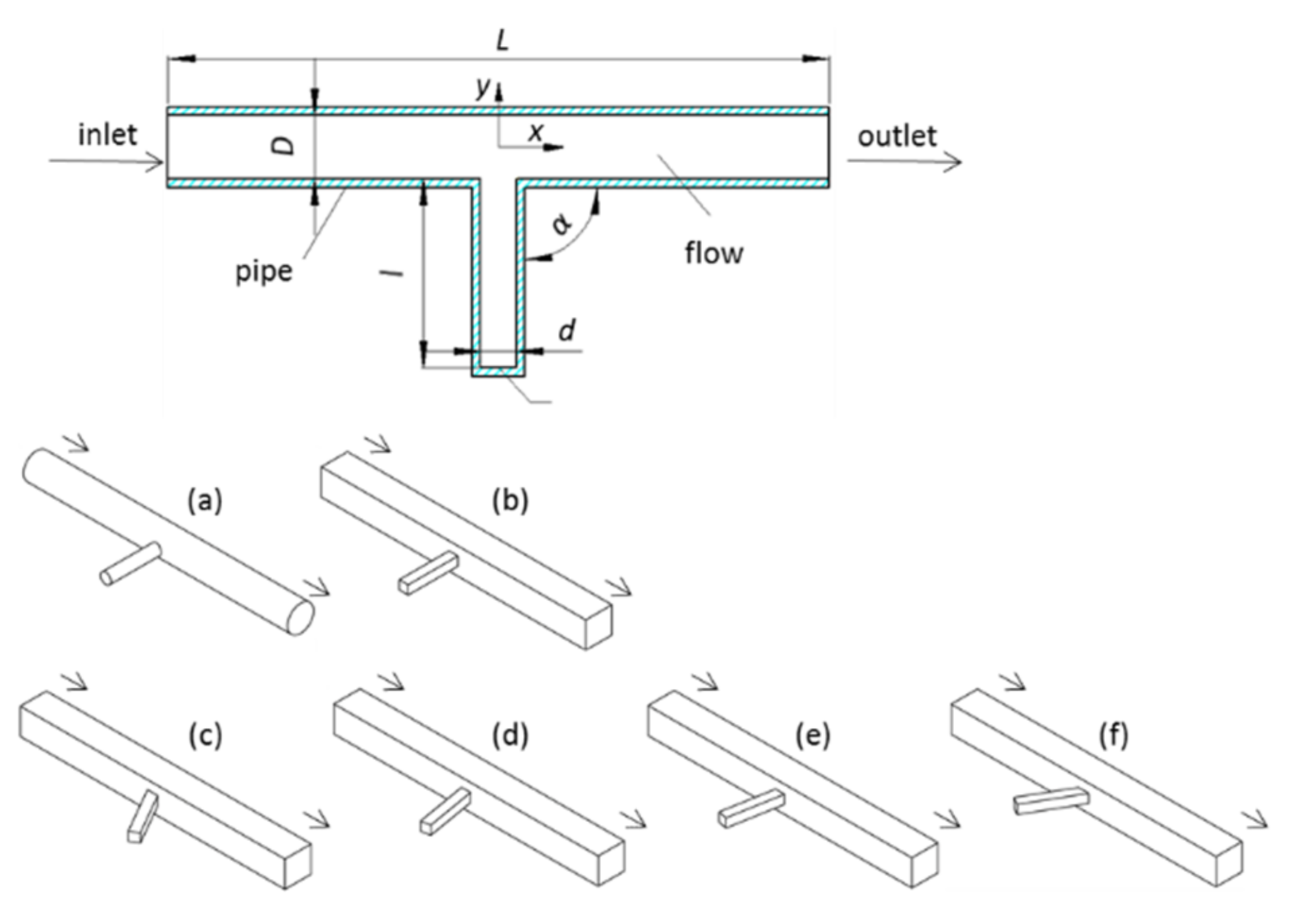

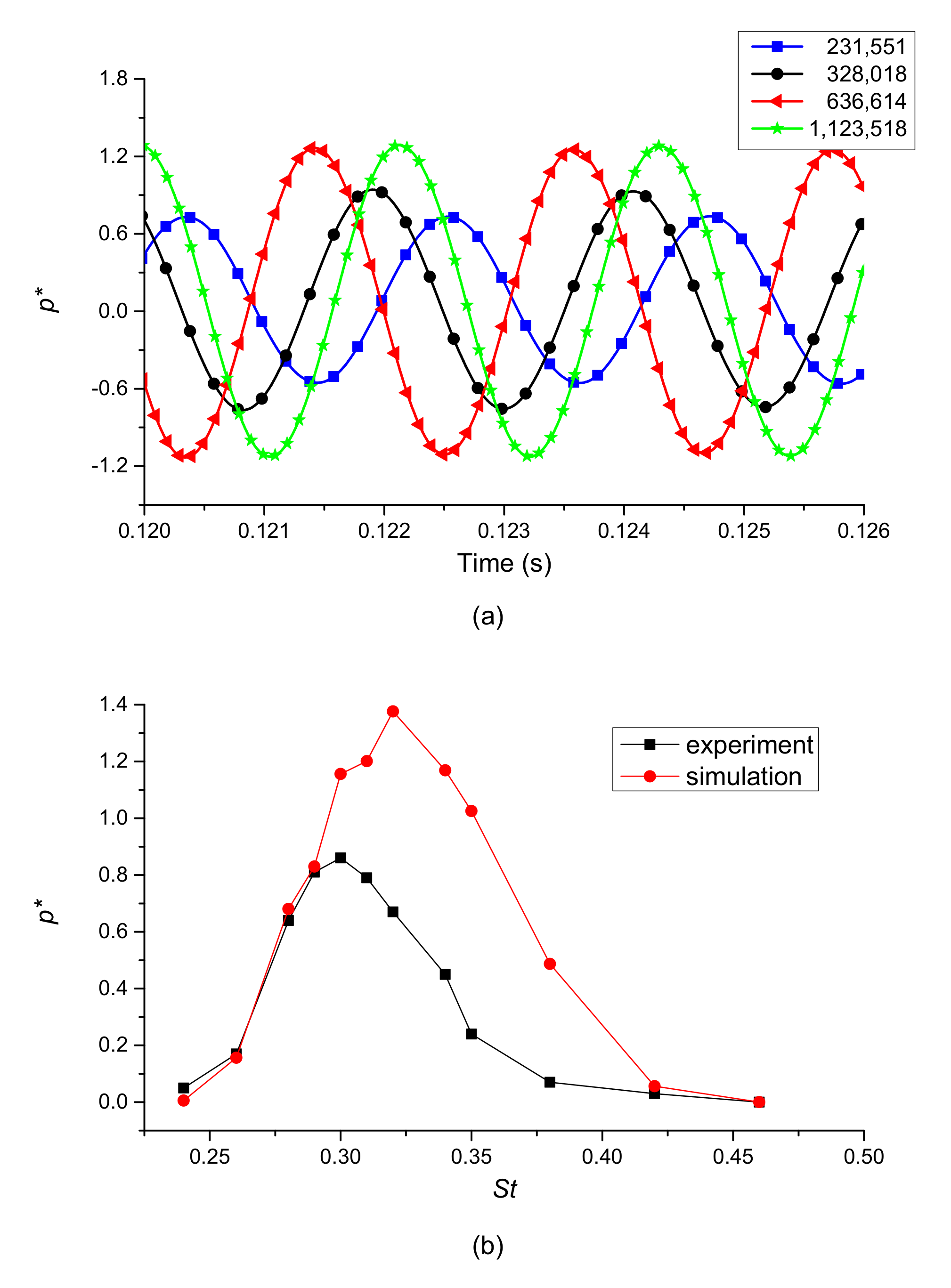
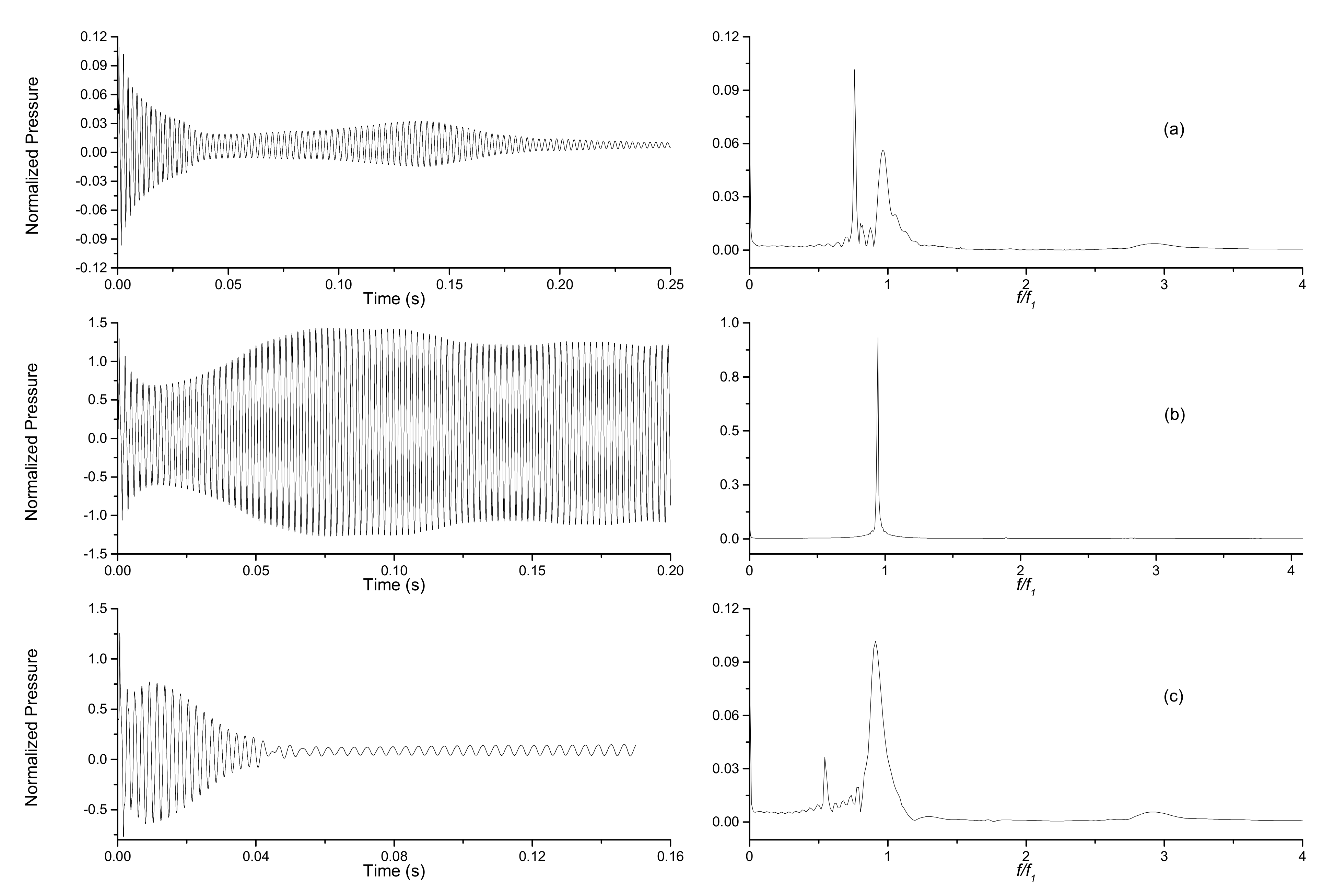
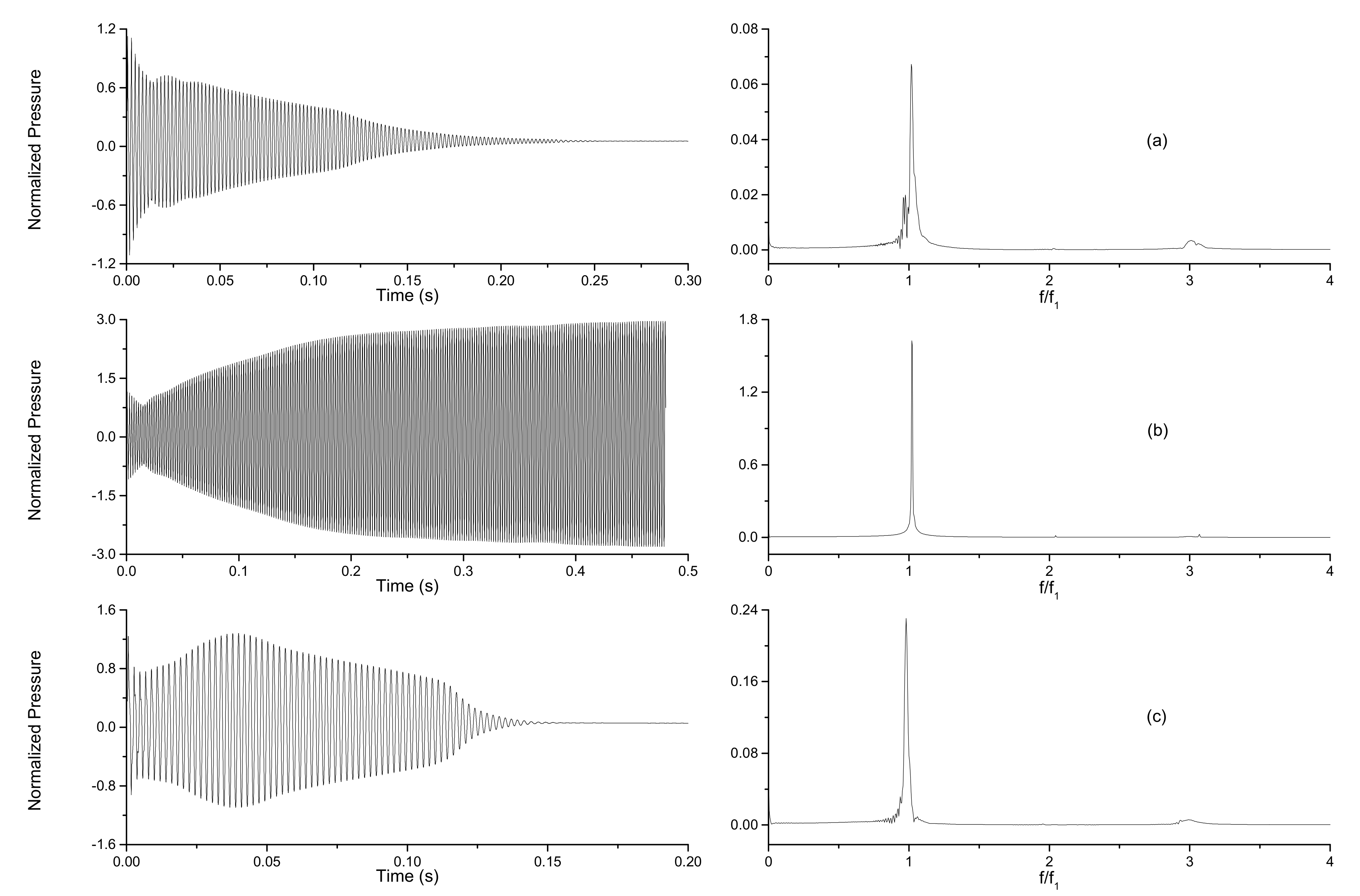

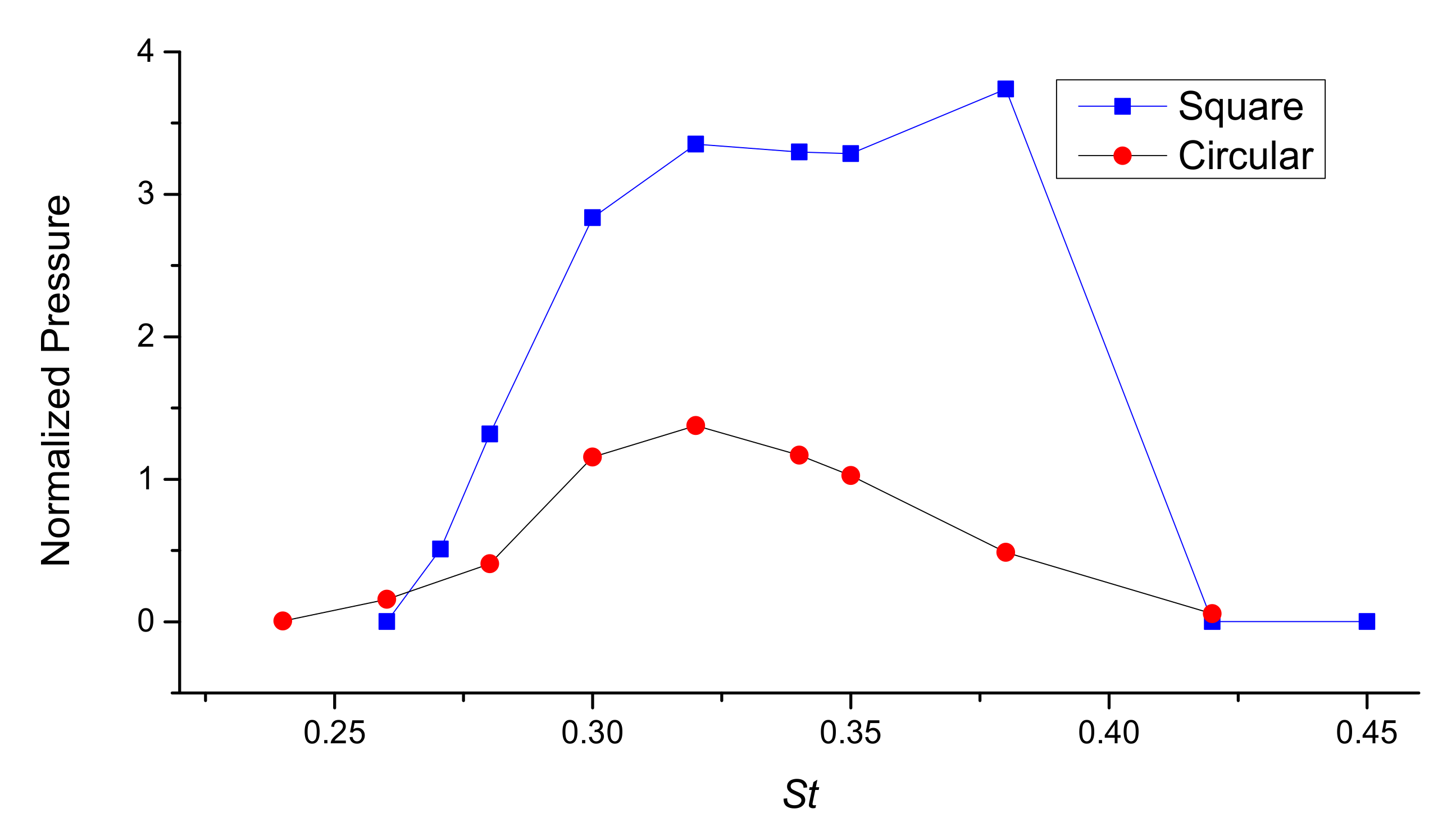
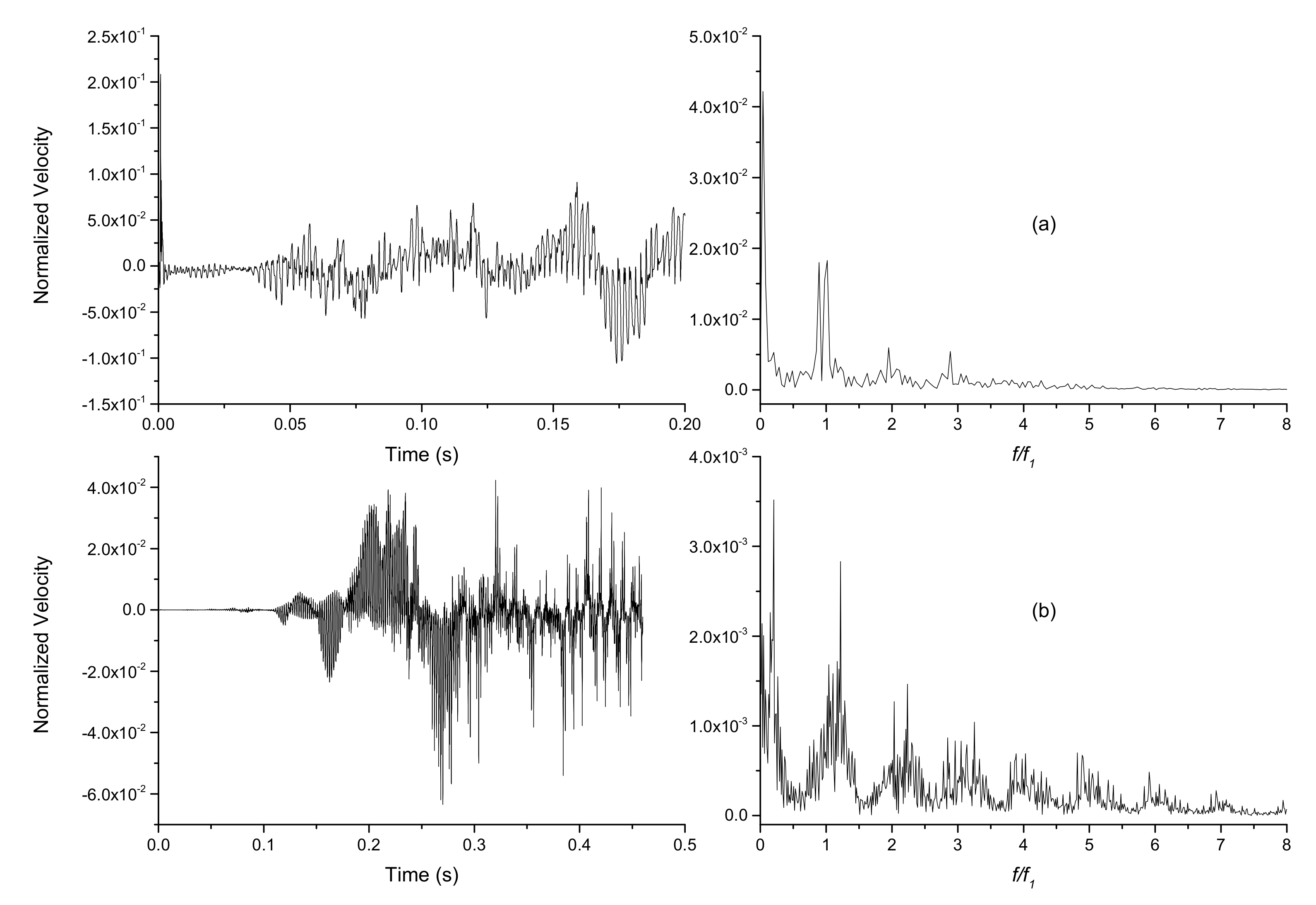
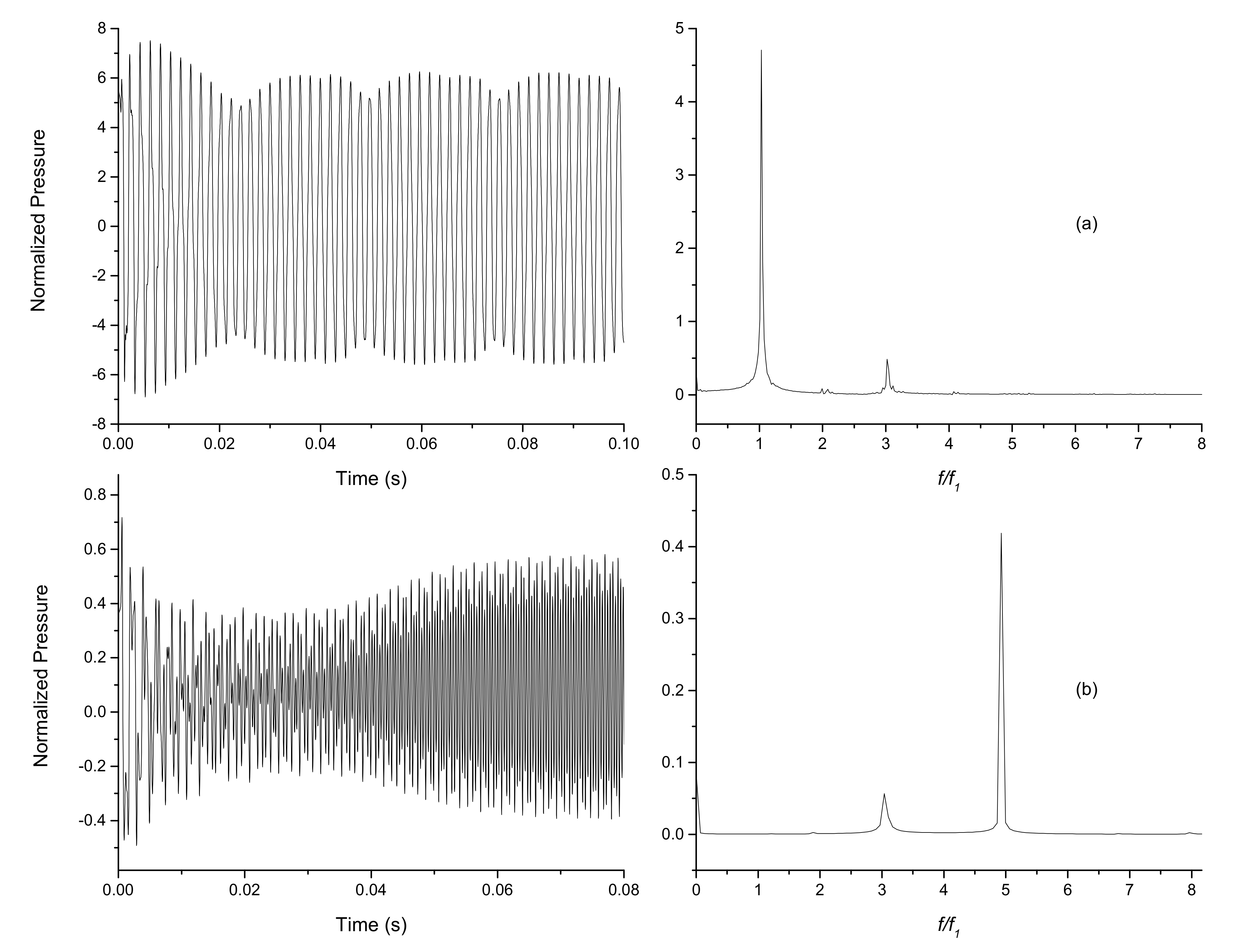

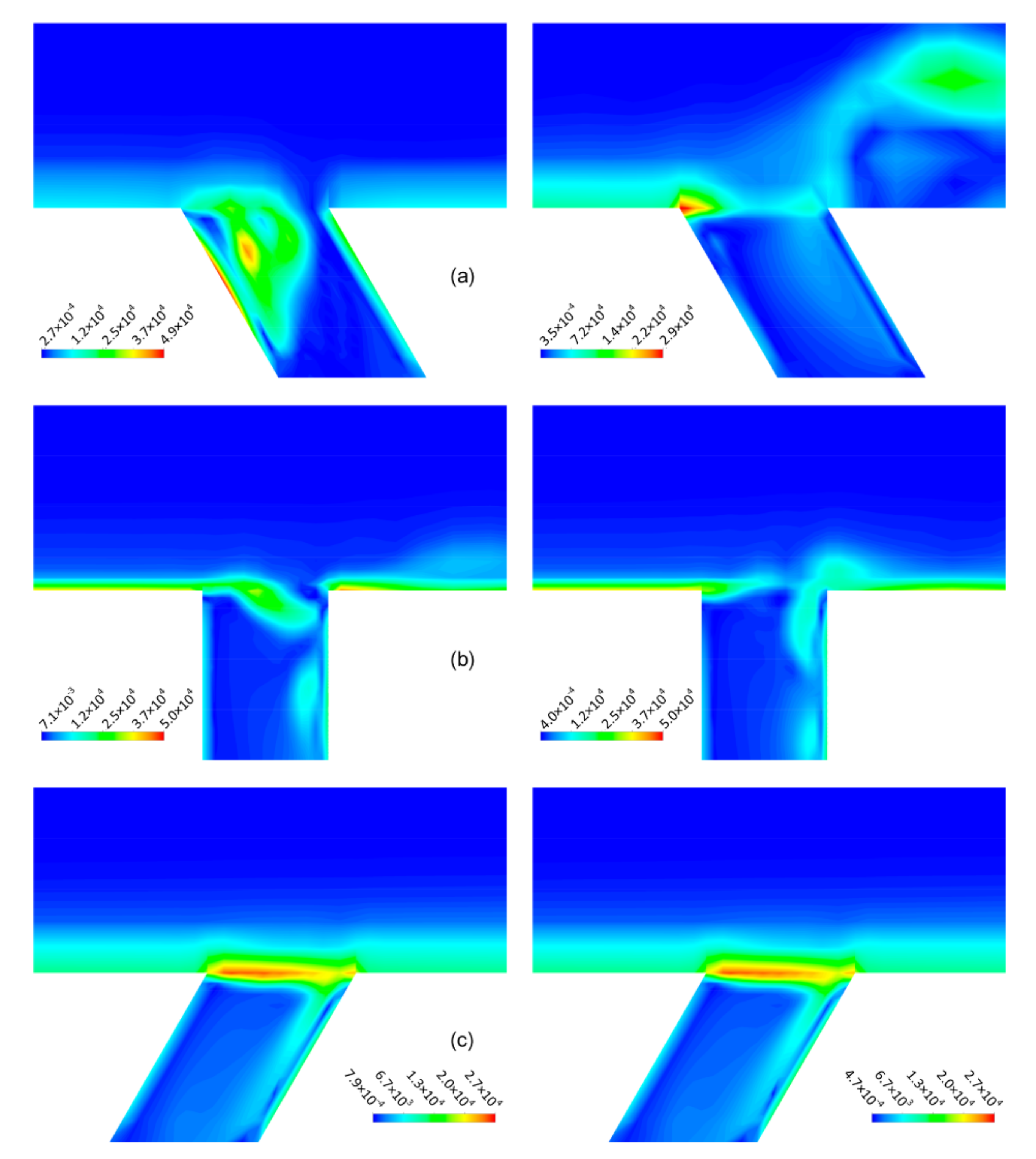
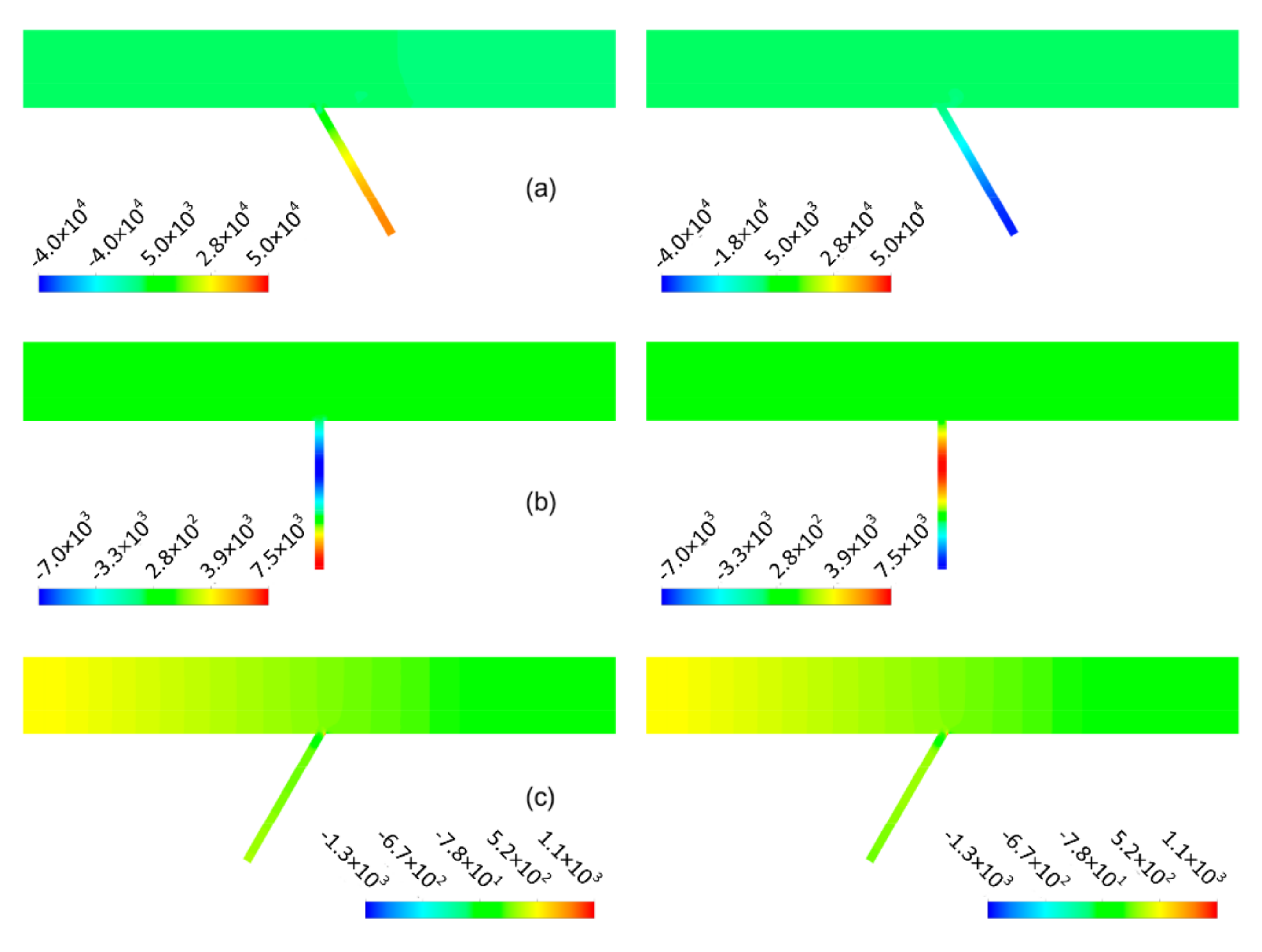
| Case | Main Pipe Cross-Section Shape | Branch Cross-Section Shape | Branch Angle A |
|---|---|---|---|
| 1 | Circular | Circular | 90° |
| 2 | Square | Square | 90° |
| 3 | Square | Square | 60° |
| 4 | Square | Square | 80° |
| 5 | Square | Square | 100° |
| 6 | Square | Square | 120° |
Publisher’s Note: MDPI stays neutral with regard to jurisdictional claims in published maps and institutional affiliations. |
© 2021 by the authors. Licensee MDPI, Basel, Switzerland. This article is an open access article distributed under the terms and conditions of the Creative Commons Attribution (CC BY) license (http://creativecommons.org/licenses/by/4.0/).
Share and Cite
Jiang, L.; Zhang, H.; Duan, Q.; Liu, X. Numerical Simulation of Acoustic Resonance Enhancement for Mean Flow Wind Energy Harvester as Well as Suppression for Pipeline. Energies 2021, 14, 1725. https://doi.org/10.3390/en14061725
Jiang L, Zhang H, Duan Q, Liu X. Numerical Simulation of Acoustic Resonance Enhancement for Mean Flow Wind Energy Harvester as Well as Suppression for Pipeline. Energies. 2021; 14(6):1725. https://doi.org/10.3390/en14061725
Chicago/Turabian StyleJiang, Liuyi, Hong Zhang, Qingquan Duan, and Xiaoben Liu. 2021. "Numerical Simulation of Acoustic Resonance Enhancement for Mean Flow Wind Energy Harvester as Well as Suppression for Pipeline" Energies 14, no. 6: 1725. https://doi.org/10.3390/en14061725
APA StyleJiang, L., Zhang, H., Duan, Q., & Liu, X. (2021). Numerical Simulation of Acoustic Resonance Enhancement for Mean Flow Wind Energy Harvester as Well as Suppression for Pipeline. Energies, 14(6), 1725. https://doi.org/10.3390/en14061725








